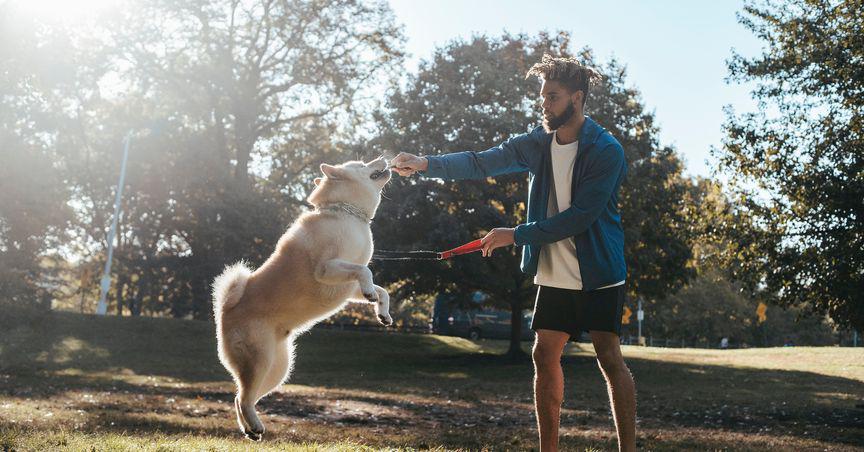If you want your dog to grow up to be well-behaved and happy, you must take the time to develop a solid relationship of trust with it. Daily practice of the most fundamental commands is a must for any puppy.
Keep training sessions lighthearted; if you know you won't be able to treat it well because of stress, don't bother. Dogs are highly sensitive creatures and can detect the tension in your body.
Training a dog to follow basic commands is only one part. Negative behaviors like aggression, anxiety, and harm to others are what dog training is primarily aimed at reducing. A well-mannered doggy with traits like self-assurance, flexibility, and friendliness will find it easy to settle into various social and environmental contexts.
You and your furry friend can build trust and better communicate with one another through training sessions. You can lay the groundwork for a happy and lasting relationship by cooperating and paying attention to one another's needs.
Training your dog benefits their behavior and also makes their bond with you stronger. Learning your pet's language helps you bond with it and gain insight into its individual character.
As a result, make training a regular part of your schedule to maintain peace and harmony with your dog.
The Beginning of Training
Creating a Safe Environment
Before starting training, ensure your dog has a comfy bed, some toys, and a quiet place to retreat to help them feel safe and at ease.
Defining Boundaries and Rules
When training your dog, consistency is vital, and it will benefit from having clear guidelines for what is and is not allowed in terms of behavior.
Maintain Order
Providing a clean and orderly space for your pup is a crucial part of pet ownership. Saving time and effort in the search for items like toys, treats, and grooming supplies is possible with a well-organized system. You need nothing more than an awesome free label maker.
You can create custom labels that you can use to identify the contents of a jar, the date a batch of treats was made, or even the dog that belongs with a specific toy.
Organization and labeling of its belongings will save you time and frustration. The same applies to your dog, who will appreciate your care for their wellbeing.
Techniques for Positive Reinforcement
Training dogs with positive reinforcement is efficient and compassionate. You can encourage them to repeat desired behaviors by rewarding them. Here are some strategies:
Incentives and Treats
The practice of rewarding trainees with treats is well-liked. When your dog behaves the way you want, appreciate them with small, delectable treats that they enjoy. It establishes a good place and motivates them to maintain their appropriate behavior.
Clicking Exercises
Clicker training involves marking desired behaviors with a clicker, a tiny handheld device that emits a distinct clicking sound. You can tell your dog when they've done something right by using the clicker sound and a treat.
Verbal Gratitude and Love
Verbal praise and affection are essential components of positive reinforcement, along with treats and clickers. Give him plenty of praise, affection, and encouraging words when they behave well because they live to win our approval.
Getting Your Dog Socialized
The following advice will help you socialize your dog:
Introduce It to Various Environments
Gradually introduce your dog to various settings, such as parks, busy streets, and indoor areas. Exposing them to sights, sounds, and smells early on helps them develop into well-adjusted, self-assured individuals.
Introduce It to People and Other Animals
Socializing with people and other animals is crucial for your dog's development. Introduce people, including kids and adults, to dogs through controlled, positive interactions to slowly discourage aggressive behavior motivated by fear.
Managing Frequent Behavior Problems
There are still some behavioral issues that can affect even the best-behaved dogs. Some typical problems and advice for fixing them are listed below.
- It can be annoying when they bark constantly. Learn what sets off your dog's barking episodes, and do something about it. Consider desensitization strategies and interactive toys as potential replacements for destructive behaviors.
- They often jump on people as a way to get attention. Reward it for keeping their cool when meeting new people, and teach them a sit as an alternative greeting behavior.
- They naturally engage in behaviors such as chewing and digging, but these instincts can become destructive if they are towards household items or plants. Provide your dog with plenty of safe chew toys and a designated digging area outside.
Conclusion
When training a pet, a holistic approach entails considering the dog as a whole and training accordingly. The path to a well-behaved best friend requires patience, consistency, and dedication.
Training can profoundly affect your relationship with it, making it a pleasure to be around. Always use positive reinforcement techniques and never resort to punishment-based methods, as the latter can harm your dog's mental health.


_09_03_2024_01_03_36_873870.jpg)

